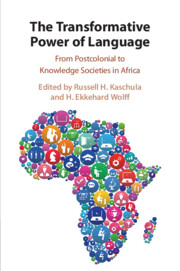Book contents
- The Transformative Power of Language
- The Transformative Power of Language
- Copyright page
- Contents
- Figures
- Tables
- Contributors
- Preface
- Abbreviations and Acronyms
- Introduction
- Part I Mental Decolonisation and Cultural Diversity
- Part II Multilingualism and Intellectualisation of African Languages
- 4 Transformative Power of Language Policies in Higher Education
- 5 African Languages in Transformation
- 6 Linguistic Diversity in Higher Education
- 7 An Impact Study with Reference to isiXhosa and Afrikaans Multilingual Glossaries for First-Year Law of Contracts Students at Cape Peninsula University of Technology
- 8 The Need for Multicultural and Multilingual Sensitivity in Transforming Graphic Design Curriculum in a University of Technology
- 9 An Analysis of the Language Legislation Effects in the Banking Sector
- Part III Digitalisation and Democratisation of Knowledge
- Part IV Interlingual and Intercultural Cross-Fertilisation
- Index
- References
8 - The Need for Multicultural and Multilingual Sensitivity in Transforming Graphic Design Curriculum in a University of Technology
from Part II - Multilingualism and Intellectualisation of African Languages
Published online by Cambridge University Press: 18 September 2020
- The Transformative Power of Language
- The Transformative Power of Language
- Copyright page
- Contents
- Figures
- Tables
- Contributors
- Preface
- Abbreviations and Acronyms
- Introduction
- Part I Mental Decolonisation and Cultural Diversity
- Part II Multilingualism and Intellectualisation of African Languages
- 4 Transformative Power of Language Policies in Higher Education
- 5 African Languages in Transformation
- 6 Linguistic Diversity in Higher Education
- 7 An Impact Study with Reference to isiXhosa and Afrikaans Multilingual Glossaries for First-Year Law of Contracts Students at Cape Peninsula University of Technology
- 8 The Need for Multicultural and Multilingual Sensitivity in Transforming Graphic Design Curriculum in a University of Technology
- 9 An Analysis of the Language Legislation Effects in the Banking Sector
- Part III Digitalisation and Democratisation of Knowledge
- Part IV Interlingual and Intercultural Cross-Fertilisation
- Index
- References
Summary
Graphic design is a learning area that relies on the use of visual representation, involving images and/or text, to convey meaning. By its very nature, visual communication is a language that is vulnerable to an unintended array of misinterpretations because of the differing semiotic backgrounds of its consuming audiences. Thus, students need to be equipped with the necessary cultural awareness to design communication that is sensitive to the varying needs of these audiences. This study employs a case study approach with a view to interrogating the curriculum in relation to multiculturalism in the graphic design curriculum. Data for this study were obtained through participant observation, semi-structured informal interviews and document analysis. From a theoretical perspective, the paper draws on Vygotsky’s (1978) sociocultural learning to examine the role of culture in the teaching and learning of culturally diverse students, as well as Phillion’s (2002) narrative multiculturalism to understand the narratives of the respondent students, lecturers and an industry expert. The findings point to a lack of a cohesive and coordinated approach to teaching and learning and reflect a lack of sensitivity to cultural and linguistic diversity in the Graphic Design Department.
Keywords
- Type
- Chapter
- Information
- The Transformative Power of LanguageFrom Postcolonial to Knowledge Societies in Africa, pp. 176 - 192Publisher: Cambridge University PressPrint publication year: 2020



